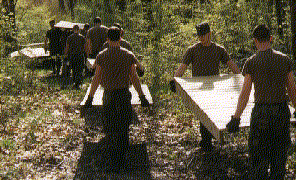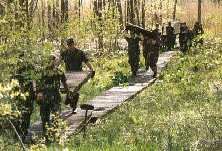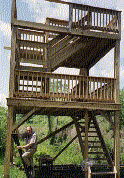The Causeway
"a communication across the low ground between the right and left wings of the Army is instantly to be completed."
General Orders of General Washington February 24, 1783.
Remember that Washington's army was made up of at least 6,000 troops spread out over 1,600 acres. The two wings were separated by extensive marshlands. A causeway would run in a line from the 1st and third Massachusetts Brigades (left wing) to a point between the New York and New Jersey Regiments (right wing). In all, this unique roadway would be some 1,400 feet in length. Once the route was selected, the area was measured and staked to determine the exact footage.
The causeway was to be constructed of "saucissons," long bundles of bound brush and sticks resembling a thick sausage. Washington specified that each saucisson was to be "well bound with seven bands, twelve feet in the clear between each binding and at leas one foot in diameter." They were to be inspected and those failing to meet specifications would be rejected. The saucissons were placed in two layers and were then covered with earth and gravel dug from drainage ditches on either side. In all, 4,320 saucissons were required and the work was divided between the brigades according to their size. The Massachusetts Brigades, having the larger number of men, were assigned 2,160. The New Hampshire contingent, the smallest, 530.
Today a modern day walkway has been constructed and it serves as part of a nature trail.
In the two shots below, cadets from nearby West Point work on the causeway. Washington's troops are still carrying out his orders.



The causeway leads to an observation tower from which you can view the surrounding woods and wildlife. Above, historian Don Gordon enjoys the site.